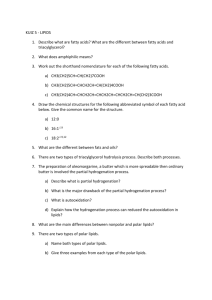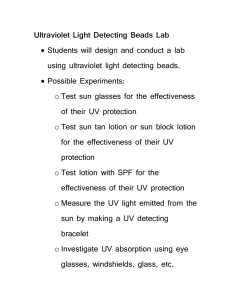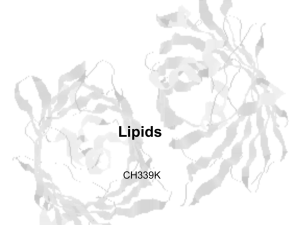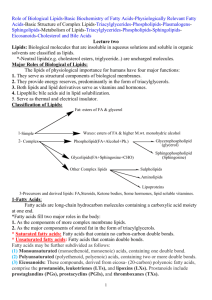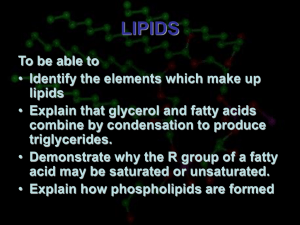Experiment_33_making_lotions
advertisement
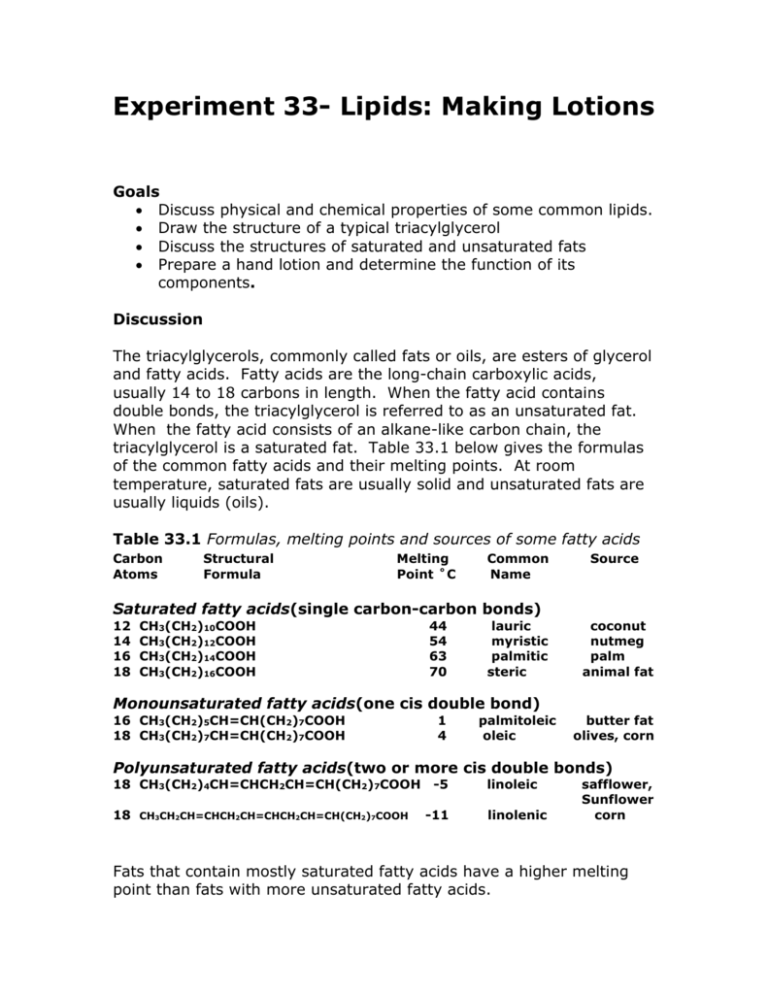
Experiment 33- Lipids: Making Lotions Goals Discuss physical and chemical properties of some common lipids. Draw the structure of a typical triacylglycerol Discuss the structures of saturated and unsaturated fats Prepare a hand lotion and determine the function of its components. Discussion The triacylglycerols, commonly called fats or oils, are esters of glycerol and fatty acids. Fatty acids are the long-chain carboxylic acids, usually 14 to 18 carbons in length. When the fatty acid contains double bonds, the triacylglycerol is referred to as an unsaturated fat. When the fatty acid consists of an alkane-like carbon chain, the triacylglycerol is a saturated fat. Table 33.1 below gives the formulas of the common fatty acids and their melting points. At room temperature, saturated fats are usually solid and unsaturated fats are usually liquids (oils). Table 33.1 Formulas, melting points and sources of some fatty acids Carbon Atoms Structural Formula Melting Point ˚C Common Name Source Saturated fatty acids(single carbon-carbon bonds) 12 14 16 18 CH3(CH2)10COOH CH3(CH2)12COOH CH3(CH2)14COOH CH3(CH2)16COOH 44 54 63 70 lauric myristic palmitic steric coconut nutmeg palm animal fat Monounsaturated fatty acids(one cis double bond) 16 CH3(CH2)5CH=CH(CH2)7COOH 18 CH3(CH2)7CH=CH(CH2)7COOH 1 4 palmitoleic oleic butter fat olives, corn Polyunsaturated fatty acids(two or more cis double bonds) 18 CH3(CH2)4CH=CHCH2CH=CH(CH2)7COOH 18 CH3CH2CH=CHCH2CH=CHCH2CH=CH(CH2)7COOH -5 -11 linoleic linolenic safflower, Sunflower corn Fats that contain mostly saturated fatty acids have a higher melting point than fats with more unsaturated fatty acids. O CH2OH CH2O O + CHOH 3 HO CHO C(CH2)14CH3 CH2OH CH2O Glycerol 3 palmitic acids C(CH2)14CH3 O + 3 H2O C(CH2)14CH3 C(CH2)14CH3 Glyceryl palmitate (tripalmitin) Figure 1: synthesis of a triacylglycerol from glycerol and palmitic acid. O Physical properties of some lipids and fatty acids Lipids are a family of compounds that are grouped by similarities in solubility rather than structure. As a group, lipids are more soluble in nonpolar solvents such as ether, chloroform, or benzene. Most are not soluble in water. Important types of lipids include fats and oil, glycerophospholipids, and steroids. Compounds classified s lipids include fat-soluble vitamins A, D, E, and K; cholesterol; hormones; portions of cell membranes and vegetable oils. Table 33.2 lists the classes of lipids. Table 33.2 Classes of Lipid Molecules Lipids Components Waxes Fatty acid and long-chain alcohol Fats and oils(triacylglycerols) Fatty acid and glycerol Glycerophospholipids Fatty acids, glycerol, phosphate, amino alcohol Steroids A fused structure of three cyclohexanes and a cyclopentane The structural formulas of three typical lipids are shown below: O H3C CH3 CH3 O CH3 CH3 CH2O C(CH2)16CH3 O CHO C(CH2)16CH3 CH2O C(CH2)16CH3 CH3(CH2)14C O(CH2)29CH3 Wax HO O Cholesterol, a steroid Triacyl glycerol, a fat Figure 2: Structures of typical lipids: A steroid (left); A triglyceride (center); A wax (right). Preparation of Hand lotion We use hand lotions and creams to soften our skin and reduce dryness. Typically, the formulation of a hand lotion consist of several components such as steric acid, lanolin, triethanolamine, cetyl alcohol, glycerin (glycerol), water, and usually a fragrance. Lanolin from wool consists of a mixture of waxes. Because lipids are non-polar, they protect and soften by preventing the loss of moisture from the skin. Some of the components help emulsify the polar and nonpolar ingredients. In this experiment we will see how the physical and chemical properties of lipids are used to prepare a hand lotion. Lab Information Materials: Stearic acid, cetyl alcohol, lanolin, triethanolamine, glycerol, ethanol, distilled water, fragrance (optional), commercial hand lotions, 10-mL graduated cylinder, 50-mL graduated cylinder, two 100-mL beakers, thermometer, 250-mL beaker for water bath, hot plate, stirring rod, tongs, pH paper. Obtain the following substances and combine in two 100-mL beakers. Use a laboratory balance to weigh out the solid substances. Use a 10mL graduated cylinder to measure glycerin; use a plastic pipet with gradient for Triethanolamine; use a 50-mL graduated cylinder to measure larger volumes. Beaker 1 Stearic acid Cetyl alcohol Lanolin Triethanolamine 3g 1g 2g 1mL Beaker 2 Glycerin 2 mL Water 50 mL Water bath: Fill two 250-mL beakers about 2/3 full with water. Place the beakers on a hot plate and heat the water to just below boiling. Using a pair of crucible tongs, hold beaker 1 (four ingredients) in the water bath and heat to 80˚C or until all the compounds have melted. Make sure all compounds stay dissolved. Using a pair of crucible tongs, hold beaker 2 (two ingredients) in the second water bath and heat to 80˚C. Remove beakers from heat. While still warm, slowly pour the glycerol-water mixture from Beaker 2 into Beaker 1 as you stir. If your lotion is too thick, add 5.0 mL of ethanol and a few drops of fragrance, if desired. Continue to stir for 3-5 minutes until a smooth creamy lotion is obtained. If the resulting product is too thick, add more warm distilled water. Using pH paper and a stirring rod, obtain the pH of your lotion. For comparison, take the pH of at least 2 commercial hand lotions provided as well. Create a table to show your data. Package your lotions into the provided plastic baggie or in a bottle from home. Remember that lotions spoil after about 9 months of preparation with out preservatives. The lotion you have prepared today contains no preservatives. To extend the life of your lotion, you may add some vitamin E (about 5 drops is good). Pre-lab Questions 1. Make a table with the physical and chemical properties of the ingredients for the preparation of lotion. (Molecular mass, chemical structure, m.p, b.p., density, solubility in water, flammability, and toxicity/hazards). 2. Draw the Lewis structure of each ingredient for the preparation of lotion. Label each functional group present. 3. Classify each ingredient for the preparation of lotion using table 33.2. Briefly explain your choices for classification. 4. Create a flow-chart for the experiment. This will be your procedures. In-lab Questions 1. Report the pH of your hand lotion and the commercial hand lotions available. Discuss what pH range is safe for use with lotions. 2. Report the quantity of lotion obtained (by volume). Suggest ways to increase the yield of lotion for the experiment. 3. Describe the smoothness and appearance of the hand lotion. Compare with a commercial lotion (provide name and manufacturer). 4. Speculate on the function of each ingredient in the preparation of hand lotion. 5. How would eliminating triethanolamine affect the consistency of the hand lotion? 6. How would eliminating steric acid affect the consistency of the hand lotion?
